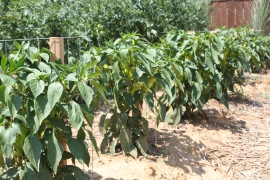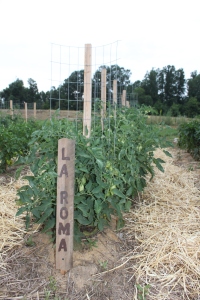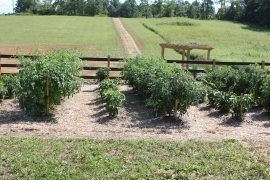How To Build The Ultimate Tomato Cage For Under $2….The Stake-A-Cage
33
You may chuckle at the name – but “Stake-A-Cage” really is the best way to describe the trellis system we came up with a few years ago to effectively and inexpensively tie up our tomatoes and peppers. We get a lot of questions about it on the blog – so we thought today we would explain it in detail, along with details at the end of the post on how to make your own.
A few years back, with the garden planted, and about 45 tomato plants growing quicker than we imagined – we knew we needed to give them support and fast! After suffering sticker shock at the prices of tomato cages and stakes in the store, we decided to see what we could come up with ourselves.
We had some left-over welded wire fencing from building the outdoor run for the chicken coop, along with wooden stakes we had used to stake out the area where the coop and barn would go. So – in desperate need to tie up some tomato plants that were falling over – we used wire cutters to quickly cut the fencing into small grid panels. Next, we attached them to the wooden stakes with fencing nails we had on hand – and the Stake-A-Cage was born.

The Stake-A-Cages in use in our garden early in the season. They provide strong support and are easy to tie as they grow

The tomatoes and peppers mid-season. The open cage and strong support of the stake keep the tomatoes growing up and keep the rows neat and clean

We made smaller stake a cages for our peppers as well – here, our banana peppers are neatly tied to the cage
After we put a few up – we started realizing that we had something! Not only did they go together easily – they looked great and had a lot of advantages over the commercial cages or old wooden stakes we had used in the past.
For starters, it combines the best of the two old ways used to tie up tomatoes; the strength of strong wooden stake with the ease of a wire trellis cage.
Although stakes are strong in the soil – it’s always been hard to tie the vines to them as the plants grow larger throughout the season. And although cages provide a better support for the tomato plants – they become hard to pick through as the plants grow. Not to mention our cages always seemed grow right out of the ground and topple over as the season progressed.
Hence, the use of the Stake A Cage. The support of a 4′ long wooden stake – attached to an open-faced wire mesh grid. Strong and durable and cheap! It combines the durability of staking tomatoes with the ease of a cage. Better yet, by keeping the wire grid flat and not making a true cage – you can tie your tomatoes easily to the grid – and when it comes time to pick – you won’t have to reach through the cages to get to the goods. The fruit and vegetables are right in front of you – and easy to harvest.
We have used ours now for three seasons and they are still going strong – and you can make them yourself with little effort for about $2 a piece! That’s a far cry from the $5 to $25 you can pay for cages, stakes and trellises found in the stores!
How To Make Them:
Materials Needed:
Wire Cutters, Hammer, A Chop Saw or Jig Saw
2×2 Lumber For Stakes
Fencing Nails (Sometimes referred to as U – Nails)
30″ High Welded Wire Galvanized Fence with 2″ x 4″ Mesh Grid (You can buy a 25′ roll which makes enough for about 16 cages for tomatoes, or 25 for peppers)
The Stakes:
There are a couple of options to make or buy your stakes. If you are starting from scratch, the easiest option is to buy inexpensive 2x2x8 framing lumber at your local home improvement / lumber store (usually for around$1.25. each) If you buy them in the standard 8′ pieces, you can simply cut in half to make 2 from each board.
There are a couple of options to make or buy your stakes. If you are starting from scratch, the easiest option is to buy inexpensive 2x2x8 framing lumber at your local home improvement / lumber store (usually for around$1.25. each) If you buy them in the standard 8′ pieces, you can simply cut in half to make 2 from each board.
After using up the grade stakes we had on hand, we made the remainder of our stakes from scrap 2×4′s and 2×6′s. Running them through the table saw lengthwise to make 2×2′s and then cutting them into 4 foot pieces.
To make a sharp point on the stakes – we then used a chop saw (jig saw works great too) to cut angled points into the end of one side. If you angle all four sides – it makes for a sharper point to drive into the ground.
***One extra note here: Since we use these in the garden and around our plants – we have always used regular, untreated lumber. Yes, it’s true that it will not last as long as treated lumber – but if you store them each winter – you should be able to use them for a good 5 years. When they do start to go bad – you can simply remove the metal grid, and put on a new stake for the next 5 years! The wire mesh is galvanized, so it will not rust and can be re-used over and over.
Once you have your stakes ready – the rest is a piece of cake! Roll out the galvanized welded wire roll, and using wire cutters - just snip off 18″ wide sections for tomatoes, or 12″ sections if you will be using them for peppers.
Center the wire grid on the stake with the bottom of the wire about 16″ from the bottom of the stake. (This is to allow the stake to be driven in to that depth) Then nail in 3 fencing nails, securing the wire to the stake. You have your very own Stake-A-Cage!
- Jim and Mary



